
The Battle of Bunker Hill was fought on June 17, 1775 during the Siege of Boston in the first stage of the American Revolutionary War. The battle is named after Bunker Hill in Charlestown, Massachusetts, which was peripherally involved. It was the original objective of both the colonial and British troops, though the majority of combat took place on the adjacent hill which became known as Breed's Hill.
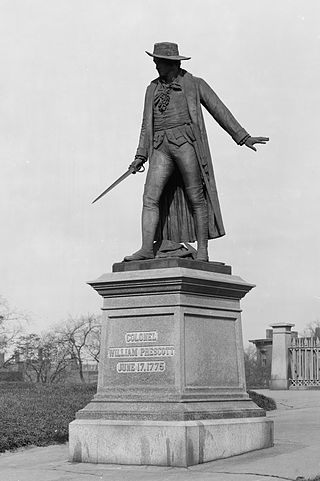
William Prescott was an American colonel in the Revolutionary War who commanded the patriot forces in the Battle of Bunker Hill. Prescott is known for his order to his soldiers, "Do not fire until you see the whites of their eyes", such that the rebel troops may shoot at the enemy at shorter ranges, and therefore more accurately and lethally, and so conserve their limited stocks of ammunition. It is debated whether Prescott or someone earlier coined this memorable saying.

John Trumbull was an American artist of the early independence period, notable for his historical paintings of the American Revolutionary War, of which he was a veteran. He has been called the "Painter of the Revolution".

Joseph Warren, a Founding Father of the United States, was an American physician who was one of the most important figures in the Patriot movement in Boston during the early days of the American Revolution, eventually serving as President of the revolutionary Massachusetts Provincial Congress. Warren enlisted Paul Revere and William Dawes on April 18, 1775, to leave Boston and spread the alarm that the British garrison in Boston was setting out to raid the town of Concord and arrest rebel leaders John Hancock and Samuel Adams. Warren participated in the Battles of Lexington and Concord the following day, the opening engagements of the American Revolutionary War.

Lieutenant Colonel James Abercrombie was a British army officer who died during the American Revolutionary War.
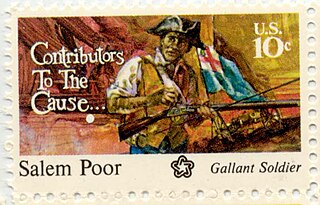
Salem Poor (1747–1802) was an enslaved African-American man who purchased his freedom in 1769, became a soldier in 1775, and rose to fame as a war hero during the American Revolutionary War, particularly in the Battle of Bunker Hill.
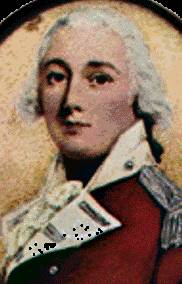
Major John Pitcairn was a Scottish military officer. Born in Dysart, Fife, he enlisted in the Marine Forces at the age of 23 and was stationed in North America during the French and Indian War, serving at the rank of captain. Arriving in Boston in 1774 as part of a British occupation of the city, he fought in the 1775 battles of Lexington and Concord during the outbreak of the American War of Independence. Two months later in June, Pitcairn was killed in action during the battle of Bunker Hill. Respected by both his men and Pitcairn's American opponents, he was buried at Boston's Old North Church.

Peter Salem was an African-American from Massachusetts who served as a U.S. soldier in the American Revolutionary War. Born into slavery in Framingham, he was freed by a later master, Major Lawson Buckminster, to serve in the local militia. He then enlisted in the Continental Army, serving for nearly five years during the war. Afterwards, he married and worked as a cane weaver. A monument was erected to him in the late 19th century at his grave in Framingham.

The 6th Massachusetts Regiment also known as the 4th Continental Regiment was raised on April 23, 1775, under Colonel John Nixon outside of Boston, Massachusetts. The regiment would see action at the Battle of Bunker Hill, New York Campaign, Battle of Trenton, Battle of Princeton and the Battle of Saratoga. The regiment was furloughed June 12, 1783, at West Point, New York and disbanded on November 3, 1783.
William Stark was a Revolutionary War era officer. He was the brother of celebrated Revolutionary war hero John Stark.

The Battles of Lexington and Concord were some of the leading military engagements of the American Revolutionary War. The battles were fought on April 19, 1775, in Middlesex County, Province of Massachusetts Bay, within the towns of Lexington, Concord, Lincoln, Menotomy, and Cambridge. They marked the outbreak of armed conflict between the Kingdom of Great Britain and Patriot militias from America's thirteen colonies.
William Sutherland was a British officer during the American Revolution.

Benjamin Ruggles Woodbridge was an American physician, lawyer, farmer, and military officer who served as a colonel in the Massachusetts militia during the American Revolutionary War. Woodbridge was a commander at the Battle of Bunker Hill, and also owned a rum still, a wood lot, a grazing meadow, and a mill, and came to be the wealthiest man in South Hadley, Massachusetts. Colonel Woodbridge was also a member of the Massachusetts legislature for many years.

Battle Road, formerly known as the Old Concord Road and the Bay Road, is a historic road in Massachusetts, United States. It was formerly part of the main road connecting Lexington, Lincoln and Concord, three of the main towns involved in the American Revolutionary War. It was on Battle Road that thousands of colonial militia and British regulars fought during the redcoats' retreat from Concord to Boston on the morning and afternoon of April 19, 1775.
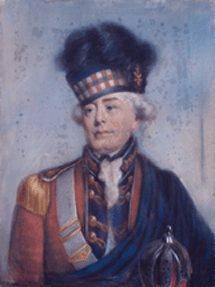
Major-General John Small was a career British military officer from Scotland who played a key role in raising and leading the 84th Regiment of Foot during the American Revolution. After the war, he settled with many of the men of the 84th Regiment in Douglas Township, Hants County, Nova Scotia. He later returned to Britain. He was appointed as Lieutenant Governor of Guernsey and promoted to major general, serving from 1793 until his death in 1796.
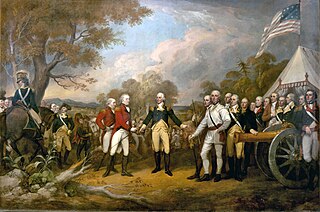
The Surrender of General Burgoyne is an oil painting by the American artist John Trumbull. The painting was completed in 1821 and hangs in the United States Capitol rotunda in Washington, D.C.

The Surrender of Lord Cornwallis is an oil painting by John Trumbull. The painting, which was completed in 1820, now hangs in the rotunda of the United States Capitol in Washington, D.C.

The Dearborn–Putnam controversy erupted in 1818 when Henry Dearborn published a post-war account of General Israel Putnam's performance during the Battle of Bunker Hill in 1775. Both Putnam and the much younger Dearborn were present before and during the battle, with Dearborn at the front lines while Putnam was about the battle scene directing troops and overseeing the construction of fortifications before the fighting began. Accounts of Putnam's presence during the battle, however, have varied among veteran officers of the battle and some historians. During the battle, there was a fair amount of disorganization among the hastily assembled Continental Army and militia, making it difficult for any one participant to give an overall assessment of everyone's performance.

Andrew McClary was an Irish soldier and major in the Continental Army during the American Revolution. McClary was born in Ulster, Ireland and came to colonial America with his parents at age sixteen where they lived on a farm in New Hampshire. Here the McClary family built a local tavern, where town meetings were also held. Many of New Hampshire's prominent and influential men had come from the McClary family. In session Andrew McClary had also become the Town Clerk and soon a notable community leader during the years before the revolution. In the mid 1700s New Hampshire frontier McClary gained much of his field experience leading expeditions against hostile Indians in the area.

The Death of General Montgomery in the Attack on Quebec, December 31, 1775 is an oil painting completed in 1786 by the American artist John Trumbull. It depicts American general Richard Montgomery at the Battle of Quebec during the invasion of Quebec. The painting is on view at the Yale University Art Gallery in New Haven, Connecticut. It is the second in Trumbull's series of national historical paintings on the American Revolutionary War, the first being The Death of General Warren at the Battle of Bunker's Hill, June 17, 1775.




















